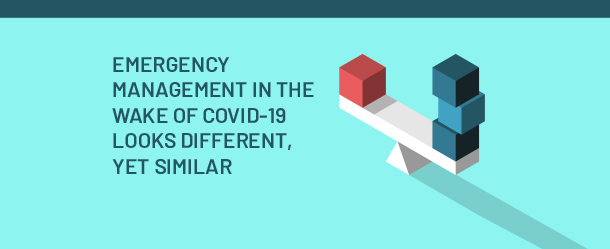



Over the past several months, MBP has been supporting a client in their COVID-19 emergency response efforts. This experience has given me time to reflect on how it differs from previous natural disasters like hurricanes and tornadoes. Yet there are many elements that remain the same regardless of the emergency type.
Without a doubt, the COVID-19 pandemic has presented government entities, and the architecture, engineering, and construction (AEC) industry with unique challenges, but also the opportunity to step back and take a look at emergency management planning and to determine how we can adapt our collective skillsets to make a positive impact.
Unlike man-made accidents, most natural disasters are unavoidable. However, they are often times predictable, and because of this, emergency management is critical to an organization’s overall resiliency and capacity to recover from any disaster. Emergency management provides strategies to understand how events evolve, generate engineering or scientific responses, and then decide how to systematically respond to myriad events. Hurricanes and tornadoes are usually forecasted, earthquakes typically occur along fault lines, and pandemics typically spread through human contact.
What is very difficult to predict is the impact these events will have. Therefore, an Emergency Management (EM) team should be in place to prepare for the expected while also planning for the unexpected. Through the proactive planning efforts of an EM team, organizations can execute through pre-planned initial responses and then assess the possible impact of anticipated unknowns. Fortunately, responders and leaders across many different sectors of our communities go through countless types of emergency management training. An AEC industry trained with the EM skillset will provide a more informed response to unique EM challenges.

The initial ownership of EM (and response) is inherently governmental as it provides for the safety and welfare of its citizens. Governmental leadership is overall responsible for the emergency response, however, most of the legwork on the ground is executed via AEC service and construction contracts. There will be competing needs, risk decisions that will need to be made with often minimal information, and work done in less-than-safe environments. This environment could include physical, chemical, and biological exposure/dangers, psychological impacts, and a high possibility of damage to life and infrastructure.
When responding to this type of event, some form of controlled chaos is typical as people respond in the best way they can with the tools provided, and thus a “fog-of-war” develops. What needs to be done? Who is officially responsible for the response effort? When will the response happen? What level of response is acceptable, and at what cost? What will auditors reveal about the emergency response three to five years down the road? After all, hindsight is 20/20. Having AEC support to develop a well-thought-out engineering response and execution plan goes a long way to minimize the challenges during a response effort.
Let’s look at the response to COVID-19. Although it is indeed unique in nature, it is very similar in response methodology and process. Here are some unique challenges associated with the emergency response for COVID-19:
The three elements above create unique COVID-19 response challenges as individual states, and the nation, are rapidly impacted by this moving target.
Based on lessons learned, the best way to respond to a situation, like COVID-19, is to trust your training, rely on experience, and document what is done so those lessons learned can be captured. These types of response efforts generate an environment where responders need to be comfortable being uncomfortable, and okay being wrong with good intentions. A key skillset is to observe and understand the outcome of initial decisions and be ready to change course should things not go as anticipated. We know that Mother Nature is not a math equation with known variables and a pre-defined answer.
Can this challenge enable a more viable AEC industry that can fluidly respond to the “new normal?” We believe it does and welcome the opportunity to support your organization’s emergency response planning and emergency response efforts should natural events continue to disrupt society as a whole. MBP is experienced in using project risk management to plan for, identify, analyze, respond to, monitor, and control risk. Contact us to see how we can help you.
Related reading: Let’s Meet the COVID-19 Challenge Together
Comments